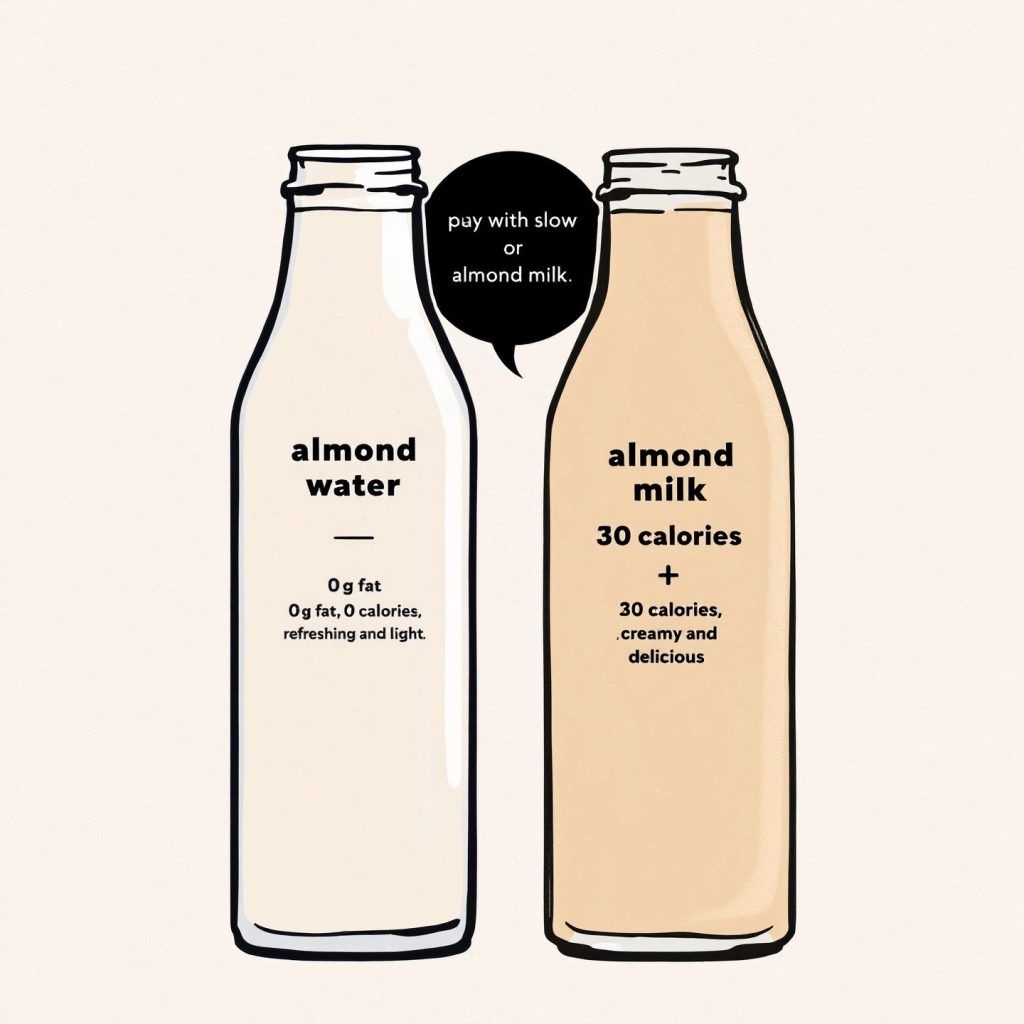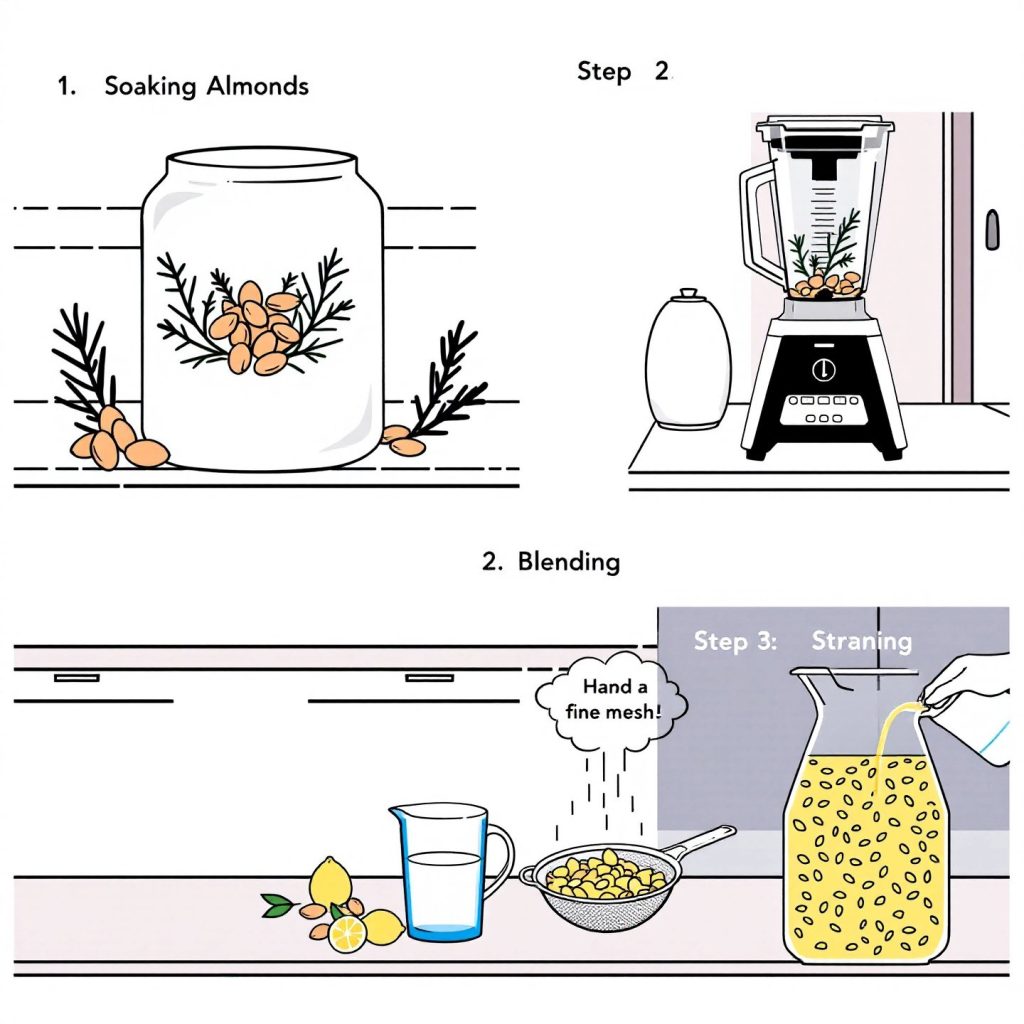Introduction: The Rising Popularity of Almond Water
Almond water is quickly becoming a staple among health-conscious consumers seeking a refreshing and nutritious alternative to traditional beverages. With its roots in French culinary tradition, almond water is celebrated for its light, nutty flavor and its ability to quench thirst without the need for artificial additives. This guide aims to walk you through a simple, step-by-step process for creating homemade almond water, allowing you to enjoy its benefits right from your kitchen.
The appeal of almond water lies not only in its delightful taste but also in its health benefits. Rich in vitamin E and antioxidants, this beverage supports skin health and provides a hydrating boost, making it an excellent choice for those looking to enhance their wellness routine. Additionally, the versatility of almond water allows for various flavor customizations, offering endless possibilities for personalizing your drink.
Join the growing number of enthusiasts who are discovering the joys of homemade almond water. Whether you’re looking to reduce your sugar intake, explore dairy-free options, or simply try something new, almond water is a delicious and beneficial choice.

Almond water vs almond milk: a visual comparison (AI-generated)
What is Almond Water?
Almond water is a delightful beverage crafted from a simple combination of almonds and water, often enhanced with subtle flavorings like vanilla or rose water. Unlike almond milk, which is creamy and used as a dairy substitute, almond water is light and refreshing, offering a distinctively nutty taste without the creamy texture. This makes it an ideal choice for those looking for a hydrating drink that isn’t as heavy as milk alternatives.
Tracing its roots back to France, almond water shares a historical lineage with orgeat syrup, a traditional French concoction made from almonds, sugar, and either rose or orange flower water. Originally, orgeat was a barley-almond blend, but modern adaptations have simplified the recipe, focusing on the almond essence that defines its character. Today, almond water maintains this simplicity, requiring just a handful of ingredients to create a versatile drink that can be enjoyed on its own or as a base for other beverages.
The beauty of almond water lies in its straightforward composition. By using high-quality almonds and pure water, you can craft a beverage that is both nourishing and adaptable, inviting you to experiment with different flavor profiles to suit your taste. This simplicity not only makes almond water an accessible choice for home preparation but also a canvas for culinary creativity.
Ingredients and Equipment Needed
Creating almond water at home is a straightforward process that requires only a few key ingredients and some basic kitchen equipment. To start, you’ll need raw almonds, which are the cornerstone of this refreshing beverage. It’s crucial to select high-quality, raw almonds to ensure the best flavor and nutritional benefits. You’ll also need fresh water, which serves as the base of your almond water, and optional sweeteners such as honey or agave, depending on your taste preferences.
For those who enjoy a hint of additional flavor, consider incorporating vanilla extract or rose water. These optional add-ins can elevate the taste, offering a personalized touch to your homemade almond water. As for the equipment, a blender is essential for breaking down the almonds into a fine meal, which is then mixed with water. A strainer or nut milk bag will help you separate the almond pulp from the liquid, ensuring a smooth and clear beverage. Finally, prepare storage containers to keep your almond water fresh and ready to enjoy.
By gathering these simple ingredients and tools, you’re well on your way to crafting a delicious and nutritious almond water that can be enjoyed plain or as a base for various flavor combinations. With the right preparation, you can easily integrate this delightful drink into your daily routine, reaping its refreshing benefits.

Step-by-step guide to making almond water (AI-generated)
Step-by-Step Almond Water Recipe
Creating almond water at home is a simple process that begins with soaking raw almonds. To achieve the best results, soak one cup of raw almonds in water overnight or for up to two days. This soaking process softens the almonds, making them easier to blend and helping to release their natural flavors. Once soaked, drain and rinse the almonds thoroughly with fresh water to remove any residual phytic acid, which can inhibit nutrient absorption.
Blending and Straining
Next, combine the soaked almonds with two to three cups of fresh water in a high-speed blender. The amount of water you use will determine the consistency of your almond water; for a lighter drink, opt for more water. Blend the mixture on high for about two minutes until the almonds are finely ground and the water turns a milky white.
After blending, it’s time to strain the mixture. Using a fine-mesh strainer or a nut milk bag, pour the almond mixture through, allowing the liquid to separate from the almond pulp. Squeeze the bag or press the strainer to extract as much liquid as possible, capturing the essence of the almonds in your water.
Flavoring and Final Touches
Once strained, you can enhance your almond water with optional sweeteners or flavorings. Add a teaspoon of honey or agave for sweetness, or incorporate a splash of vanilla extract or rose water for a fragrant twist. Stir thoroughly to ensure the flavors are evenly distributed.
For those who enjoy experimenting, consider adjusting the water-to-almond ratio for a thinner or thicker beverage, depending on your preference. This flexibility allows you to customize your almond water to suit your taste, making it a versatile addition to your beverage repertoire. With these simple steps, you can enjoy a refreshing glass of homemade almond water, tailored perfectly to your liking.
Flavor Variations and Add-ins
Almond water’s simplicity allows it to be a blank canvas for a variety of delightful flavor variations. By incorporating different add-ins, you can tailor this refreshing beverage to your taste preferences. Here are some popular flavored almond water recipes that you can try at home.
Classic Vanilla and Cinnamon
For a comforting twist, add a teaspoon of vanilla extract and a pinch of cinnamon to your almond water. These warm, aromatic flavors complement the nutty base, creating a beverage that’s both soothing and invigorating. Simply stir in these ingredients after straining your almond water, and adjust to taste.
Natural Sweetness with Dates
To naturally sweeten your almond water, consider blending in a few pitted dates. Dates not only add sweetness but also enrich the drink with additional nutrients. Blend the dates with the soaked almonds and water, then strain as usual. This method infuses a subtle caramel-like flavor that’s perfect for those who prefer a naturally sweetened drink.
Traditional French Rose Water
For a taste of French tradition, add a splash of rose water to your almond water. This fragrant addition provides a floral note that pairs beautifully with the almond’s nutty profile. Start with a small amount, about half a teaspoon, and increase as desired to avoid overpowering the drink.
Fruity and Fresh: Strawberry or Chocolate
For a fruity variation, blend a handful of fresh strawberries with the almonds and water before straining. This adds a vibrant color and a refreshing taste. Alternatively, for a chocolatey treat, mix in a tablespoon of cacao powder during the blending process. Both options offer exciting ways to enjoy almond water beyond its traditional form.
These flavor variations demonstrate the versatility of almond water, allowing you to enjoy a personalized beverage that suits your mood and occasion. By experimenting with these almond water add-ins, you can discover new favorites and keep your hydration routine exciting.

Health benefits of drinking almond water (AI-generated)
Health Benefits of Almond Water
Almond water is not only a refreshing beverage but also a nutritious addition to your diet, offering a range of health benefits. One of the primary almond water nutrition facts is its low-calorie content, making it an excellent choice for those looking to maintain a healthy weight without sacrificing taste. Each serving is typically lower in calories compared to almond milk, as it lacks the additional fats and proteins found in milk alternatives.
Rich in vitamin E, almond water supports skin health by acting as an antioxidant. This nutrient helps protect the skin from oxidative stress, which can lead to premature aging. Additionally, almond water’s hydrating properties make it an ideal choice for staying refreshed, particularly in warmer climates or after physical activity.
When compared to almond milk, almond water is lighter and contains fewer calories, fats, and proteins, yet it still offers essential nutrients that contribute to overall health. It serves as a great dairy-free alternative for those who are lactose intolerant or prefer plant-based options. Its simplicity and purity make it a gentle choice for individuals with sensitive digestive systems, aiding in digestion without the heaviness of more caloric beverages.
Another aspect of the health benefits of drinking almond water is its potential to support heart health. By providing a source of healthy fats and nutrients without the added sugars or preservatives found in processed drinks, almond water can be part of a balanced diet that promotes cardiovascular wellness.
Despite its benefits, it’s important to note that almond water should not be seen as a complete nutritional substitute for more nutrient-dense foods or beverages. Instead, it should be integrated into a varied diet to complement other sources of essential vitamins and minerals. By enjoying almond water as part of a balanced lifestyle, you can savor its refreshing taste while reaping its natural health benefits.
Storage and Shelf Life of Almond Water
Proper storage is crucial for maintaining the freshness and quality of your homemade almond water. Once prepared, almond water should be refrigerated immediately to preserve its taste and nutritional benefits. Ideally, store it in an airtight container and place it at the back of the refrigerator where the temperature remains consistently cold. This helps in extending its shelf life, which typically ranges from five to seven days.
To maximize the almond water shelf life, ensure that your storage containers are clean and dry before use. Avoid leaving almond water out at room temperature for extended periods, as this can accelerate spoilage. If you notice any off odors, flavors, or changes in color, it’s best to discard the almond water to avoid potential health risks.
For those who wish to enjoy almond water over a longer period, freezing is an excellent option. Portion the almond water into ice cube trays for easy use in smoothies or recipes. When stored in a freezer-safe bag or container, frozen almond water can last up to six months. Just remember to thaw it in the refrigerator before use to maintain its quality.
By following these storage guidelines, you can enjoy the refreshing taste of almond water while ensuring it remains safe and delicious for days to come. Next, discover creative ways to incorporate almond water into your daily routine.

Creative culinary uses for almond water (AI-generated)
Creative Uses for Almond Water
Almond water’s versatility extends well beyond being a simple refreshment. Its subtle nutty flavor and hydrating properties make it a fantastic addition to various culinary creations. By incorporating almond water into your daily routine, you can explore a range of exciting recipes that highlight its adaptability.
Smoothies and Refreshing Beverages
One of the most popular almond water uses is as a base for smoothies. Simply replace regular water or milk with almond water for a unique twist. Combine it with your favorite fruits like bananas, berries, or mangoes to create a refreshing and nutritious almond water smoothie. This not only enhances the flavor but also adds a hydrating element to your drink.
Cocktails and Iced Teas
Almond water can also be a delightful addition to cocktails and iced teas. Use it as a mixer in cocktails for a subtle nutty undertone that complements spirits like vodka or gin. Alternatively, brew a batch of iced tea and replace part of the water with almond water for a fragrant twist. Add fresh mint or a slice of lemon for extra zest.
Culinary Applications
In the kitchen, almond water shines as a dairy-free alternative in cooking and baking. Use it in place of milk when preparing oatmeal or other hot cereals for a lighter, nutty flavor. It can also be incorporated into baking recipes, such as muffins or pancakes, to provide moisture without the heaviness of dairy.
Simple Recipe Idea: Almond Water Oatmeal
For a quick and easy breakfast, try making almond water oatmeal. Simply cook your oats with almond water instead of regular water or milk. Add a pinch of cinnamon and a handful of your favorite nuts or dried fruits for a wholesome meal. This recipe showcases almond water’s ability to enhance both flavor and nutrition.
By exploring these creative uses, you can make almond water a staple in your kitchen, enjoying its benefits in a variety of ways. Whether in drinks or culinary dishes, almond water offers a refreshing and versatile option for enhancing your meals.
Conclusion: Enjoying Your Homemade Almond Water
Making almond water at home is a rewarding experience that allows you to customize flavors and enjoy a fresh, nutritious beverage free from preservatives. By following the simple steps outlined in this guide, you can craft a drink that’s tailored to your taste preferences, whether you prefer it plain or with added flavors like vanilla or rose water. The process is straightforward, requiring only raw almonds, water, and a few optional ingredients, making it accessible for anyone looking to enhance their hydration routine.
One of the significant benefits of homemade almond water is its purity and the ability to avoid additives often found in store-bought versions. This not only ensures a cleaner taste but also offers peace of mind about what you’re consuming. Additionally, creating your own almond water can be more cost-effective in the long run, especially if you’re an avid consumer of nut-based beverages.
We encourage you to experiment with different flavor combinations and discover what suits your palate best. Whether you’re using almond water as a base for smoothies, in cooking, or simply enjoying it on its own, its versatility is unmatched. For those interested in exploring more plant-based milk options, consider checking out top plant milk makers of 2025 for convenient and eco-friendly choices.
Now that you’re equipped with the knowledge and tips for making almond water, it’s time to try it yourself. Embrace the creativity and health benefits of this delightful drink, and make it a staple in your daily routine.
Frequently Asked Questions About Making Almond Water
1. What is almond water made of?
Almond water is made from raw almonds and water, often enhanced with natural flavors like vanilla or rose water for added taste.
2. How to create almond water at home?
To make almond water, soak raw almonds overnight, blend with fresh water, strain, and optionally add sweeteners or flavors like vanilla.
3. Is almond milk just almonds and water?
Almond milk contains almonds and water, but often includes additives like stabilizers. Almond water is simpler, focusing on a nutty, refreshing taste.
4. Is it good to drink soaked almond water every day?
Drinking almond water daily can provide hydration and vitamin E benefits, making it a healthy choice for skin and overall wellness.
5. How does almond water compare to almond milk?
Almond water is lighter and less creamy than almond milk, offering a refreshing alternative with fewer calories and a subtle nutty flavor.
